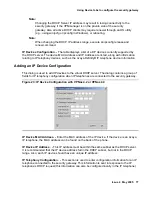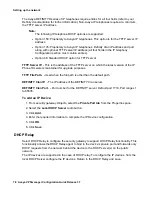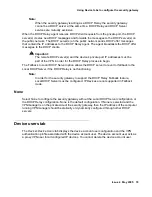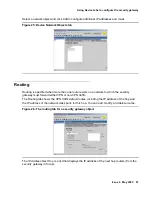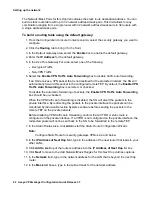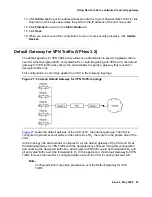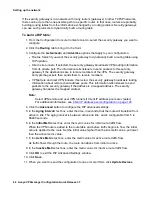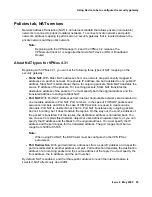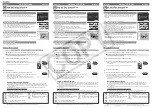
Using Device tabs to configure the security gateway
Issue 4 May 2005
91
changing it from 10.1.1.17 to 172.16.0.17. At this point, the packet’s source and destination
addresses are: 172.16.0.17 -> 172.16.1.20.
The packet is then tunneled across the public network to LA_VSU. Since the packet enters
LA_VSU through a tunnel, the NAT rule on the tunnel interface is applied to the packet changing
its destination address from 172.16.1.20 to 10.1.2.20, which is the IP address of the
LA_Sales_Group server. Before the packet is sent out of the private interface, the NAT rule on
the private interface changes the packet’s source address from 172.16.0.17 to 10.0.89.17.
Figure 29: Setting Up a VPN with Overlapping private Addresses
When a reply packet is sent from the LA_Sales_Group server to the LA_VSU, the private
interface NAT rule changes the packet’s destination address from 10.0.89.17 to 172.16.0.17
and the tunnel NAT rule changes the packet’s source address from 10.1.2.20 to 172.16.1.20
before tunneling the packet across the public network to the SF_VSU. At this point, the reply
packet’s source and destination addresses are: 172.16.1.20 -> 172.16.0.17.
Summary of Contents for 3.7
Page 1: ...VPNmanager Configuration Guide Release 3 7 670 100 600 Issue 4 May 2005...
Page 4: ......
Page 20: ...Preface 20 Avaya VPNmanager Configuration Guide Release 3 7...
Page 32: ...Overview of implementation 32 Avaya VPNmanager Configuration Guide Release 3 7...
Page 53: ...Preferences Issue 4 May 2005 53 Figure 16 Tunnel End Point Policy...
Page 54: ...Using VPNmanager 54 Avaya VPNmanager Configuration Guide Release 3 7...
Page 244: ...Using advanced features 244 Avaya VPNmanager Configuration Guide Release 3 7...
Page 292: ...Upgrading firmware and licenses 292 Avaya VPNmanager Configuration Guide Release 3 7...

